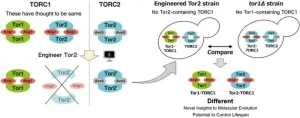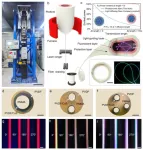The microbiome can identify those who benefit from combination immunotherapy across multiple different cancers, including rare gynaecological cancers, biliary tract cancers and melanoma.
Researchers from the Wellcome Sanger Institute, the Olivia Newton-John Cancer Research Institute in Australia, and collaborators, have identified specific strains of bacteria that are linked with a positive response to combination immunotherapy in the largest study of its kind.
The study, published today (1 March) in Nature Medicine, details a signature collection of microorganisms in an individual’s gut bacteria that may help identify those who would benefit from combination immunotherapy and help explain why the efficacy of this treatment is otherwise hard to predict.
In the future, understanding more about these bacteria strains can help drive the development of next-generation probiotics, known as ‘live biotherapeutic products’, that focus on modulating the microbiome to support combination immunotherapy from the inside.
Immunotherapy is a type of treatment that harnesses the body’s immune system to target the cancer. While it can be very effective, it only works in a proportion of recipients across a wide range of cancers. As with all cancer treatments, immunotherapy can have multiple side effects. Therefore, being able to predict who is most likely to respond to treatment helps ensure that patients do not endure these unnecessary side effects for no medical benefits.
This study used samples collected in a large, multi-centre Australian clinical trial where combination immunotherapy was effective in 25 per cent of people with a broad range of advanced rare cancers, including rare gynaecological cancers, neuro-endocrine neoplasms, and upper gastrointestinal and biliary cancers.
The clinical trial focused on a type of combination immunotherapy known as immune checkpoint inhibitors. These anti-cancer agents block the body’s immune checkpoint proteins, allowing the immune cells to destroy cancer cells. In this case, the immunotherapy blocked the PD-1 and CTLA-4 checkpoints.
Researchers used stool samples from clinical trial patients and performed deep shotgun metagenomic sequencing1 to map all the organisms within the participants’ microbiomes, down to the strain-level.
They discovered multiple strains of bacteria in those who responded well to treatment, many of which had not been cultivated before. This allowed them to identify a microbiome signature that was found in patients who responded well to treatment.
In addition to this, the team used this signature to train a machine learning model that could predict who would benefit from combination immunotherapy.
They conducted a meta-analysis of previous studies and found that their signature can be applied to different cancers, such as melanoma, and across countries, to predict individuals whose cancer will likely respond to combination immunotherapy.
However, when applied to patients who received just one of the immunotherapy drugs, targeting the immune checkpoint receptor PD-1 only, the machine-learning model could not identify those who would respond to treatment.
This suggests that the relationship between gut microbiota and treatment response is specific for particular therapeutic combinations. The researchers therefore suggest that future development of diagnostics tests or therapeutics that rely on the gut microbiome should be tailored to the immunotherapy regimen, regardless of cancer type.
This step towards personalised medicine may help extend cancer treatments to more people and can match individuals to therapies that would benefit them the most.
Dr Ashray Gunjur, first author from the Wellcome Sanger Institute and the Olivia Newton-John Cancer Research Institute, Australia, said: “Our study shows that understanding the microbiome at strain-level, not just species-level, can open up a new level of personalised medicine. Having that extra resolution is crucial if we are to understand what is happening in the human body and the interplay between cancer treatment and the microbiome. Being able to test the specific mechanisms of this relationship between specific strains and response is the next horizon in this research, and one that could benefit human health in a multitude of ways.”
Dr David Adams, co-senior author from the Wellcome Sanger Institute, said: “Rare cancers can be hard to study and treat and while immunotherapy treatment can be incredibly effective in some of these cases, it can also be unpredictable. Our research shows that the microbiome impacts how well someone responds to combination immunotherapy, but that monotherapy gives a different result. This suggests that the microbiome should be taken into account when developing therapeutics going forward. In addition to this, there is a possibility of developing live biotherapeutic products that could provide the bacteria shown to support immunotherapy, helping the microbiome work with the patient to give them the best odds of response possible.”
Dr Trevor Lawley, co-senior author from the Wellcome Sanger Institute, said: “Our microbiomes vary from person to person, all of us containing a different ecosystem of bacteria and other organisms that shape our responses to the world around us. Our research highlights how an individual’s microbiome can predict how they will respond to cancer treatment, which can have a direct clinical impact by identifying those that would benefit the most, and aid in the design of future clinical trials.”
ENDS
Contact details:
Rachael Smith
Press Office
Wellcome Sanger Institute
Cambridge, CB10 1SA
Email: press.office@sanger.ac.uk
Notes to Editors:
Shotgun sequencing allows researchers to comprehensively sample all genes in all organisms present in a given complex sample.
Publication: A. Gunjur, Y. Shao, T. Rozday, et al. (2024) A gut microbial signature for combination immune checkpoint blockade across cancer types. Nature Medicine. DOI: 10.1038/s41591-024-02823-z
Funding: This research was funded in part by Wellcome, the Cancer Research UK Cambridge Centre, and the Australian Commonwealth Government Medical Research. A full acknowledgements list can be found in the publication.
Selected websites:
About Olivia-Newton John Cancer Research Institute
The Olivia Newton-John Cancer Research Institute (ONJCRI) is a leader in the development of innovative and breakthrough cancer treatments.
Based at the Austin Hospital in Melbourne, Australia, the ONJCRI’s world-class laboratories are located just metres from hospital beds, allowing researchers and clinicians to work closely together and translate scientific discoveries into clinical trials to improve treatment options for patients.
Our researchers bring observations from the clinic back to the laboratory bench to create a continual cycle of learning and improvement between scientific research and clinical applications.
Our research is primarily focused on investigating and developing treatments for cancers of gastrointestinal tract, brain, breast, lung, skin and rare cancers. We also undertake research in understudied rare cancers and proactively look for opportunities to extend our efforts to other cancers and diseases. For more information visit www.onjcri.org.au.
The Olivia-Newton John Cancer Research Institute is a strategic partner of La Trobe University, as the School of Cancer Medicine.
The Wellcome Sanger Institute
The Wellcome Sanger Institute is a world leader in genomics research. We apply and explore genomic technologies at scale to advance understanding of biology and improve health. Making discoveries not easily made elsewhere, our research delivers insights across health, disease, evolution and pathogen biology. We are open and collaborative; our data, results, tools, technologies and training are freely shared across the globe to advance science
Funded by Wellcome, we have the freedom to think long-term and push the boundaries of genomics. We take on the challenges of applying our research to the real world, where we aim to bring benefit to people and society.
Find out more at www.sanger.ac.uk or follow us on Twitter, Instagram, Facebook, LinkedIn and on our Blog.
About Wellcome
Wellcome supports science to solve the urgent health challenges facing everyone. We support discovery research into life, health and wellbeing, and we’re taking on three worldwide health challenges: mental health, infectious disease and climate and health. https://wellcome.org/
END
New microbiome insights could help boost immunotherapy for a range of rare cancers
2024-03-01
(Press-News.org)
ELSE PRESS RELEASES FROM THIS DATE:
It’s not only opposites that attract – new study shows like-charged particles can come together
2024-03-01
A study published today in Nature Nanotechnology shows that similarly charged particles can sometimes attract, rather than repel.
The team found that like-charged particles suspended in liquids can attract one another at long-range, depending on the solvent and the sign of the charge.
The study has immediate implications for processes that involve interactions in solution across various length-scales, including self-assembly, crystallisation, and phase separation.
‘Opposites charges attract; like charges repel’ is a fundamental principle of basic physics. But a new study from Oxford University, published today in Nature Nanotechnology, has demonstrated that similarly ...
Japanese wolves are most closely related to dogs and share DNA with East Eurasian dogs
2024-03-01
In this study, we determined nine genomes of Japanese wolves and 11 genomes of modern Japanese dogs at high coverage and analyzed with one hundred dog and wolf genomes in the public database. The analyses showed that 1) the Japanese wolf was a unique subspecies of the gray wolf that is genetically distinct from both extant and ancient gray wolves known to date, 2) the Japanese wolf is most closely related to the monophyletic group of dogs. Furthermore, 3) Japanese wolf ancestry has introgressed into the ancestor of East Eurasian dogs at an early stage of the dog’s history ...
Brown bears digging up artificial forests
2024-03-01
Brown bears foraging for food in the Shiretoko Peninsula of Hokkaido, Japan, have been disrupting tree growth in artificial conifer forests, according to a new study. Researchers compared soil and tree samples from human-forested plots with samples from natural forests. They found that the bears’ digging for cicada nymphs damaged tree roots and altered the nitrogen content of the soil, which in turn limited the diameter growth of trees. The phenomena of bears digging for cicadas, an unusual food source, appears to be restricted to human-planted conifer forest; diversely vegetated natural forest ...
Innovative domain-adaptive method enables 3D face reconstruction from single depth images
2024-03-01
Reconstructing a 3D face from visuals is crucial for digital face modeling and manipulation. Traditional methods predominantly depend on RGB images, which are susceptible to lighting variations and offer only 2D information. In contrast, depth images, resistant to lighting changes, directly capture 3D data, offering a potential solution for robust reconstructions. Recent studies have turned to deep learning for more robust reconstruction from depth data; however, the scarcity of real depth images with accurate 3D facial labels has hindered the training process. Attempts to use auto-synthesized data for training have met limitations ...
Groundbreaking study unveils unique roles of yeast protein complexes in cellular lifespan and environmental response by rationally engineering based on the predicted three-dimensional structures
2024-03-01
Assistant Professor Takahiro Kosugi of Institute for Molecular Science, assistant Professor Yoshiaki Kamada at National Institute for Basic Biology, and colleagues have developed an advanced molecular cell biology approach by integrating computational redesigning of protein complexes based on the predicted three-dimensional structure into yeast genetics. They revealed that two types of protein complexes in yeast, which were thought to have the same function, play distinct roles in cellular environmental response and lifespan. Furthermore, ...
Mass-produced, commercial promising multicolored photochromic fiber
2024-03-01
Fiber, as the wearable material with the longest application in the history of humankind, is currently an ideal substrate for wearable devices due to its excellent breathability, flexibility, and ability to adapt perfectly to the 3D irregular shape of the human body. As a means of visualization in the field of functional fibers, light-emitting fiber breaks the rigidity of the traditional display interface and is expected to become an emerging interaction interface. The current commercial light-emitting fibers are polymer optical fibers and Corning® Fibrance® light-diffusing fibers. These fibers ...
General Medical Council urged to revise terminology for international medical graduates
2024-03-01
The General Medical Council (GMC) should revise its terminology regarding international medical graduates (IMGs) in the UK, argues a new commentary published in the Journal of the Royal Society of Medicine (JRSM).
The existing terminology used by the GMC fails to encompass the full spectrum of doctors facing challenges in the UK medical workforce, according to the paper’s author, Professor Mo Al-Haddad of Queen Elizabeth University Hospital, Glasgow.
Notably, he says, the GMC's definition of IMGs overlooks ...
Prostate cancer test may lead to harmful overdiagnosis in black men
2024-03-01
A new study from experts at the University of Exeter has found that a widely used test for prostate cancer may leave black men at increased risk of overdiagnosis.
Prostate-specific antigen (PSA) testing is routinely used as the first step in the UK to investigate men with urinary symptoms such as blood in urine or urinating very frequently. Men aged over 50 years without symptoms are also able to request the blood test from their GP.
The new study, published in BMC Medicine, sought to investigate the performance of the PSA test in identifying prostate cancer among men ...
Discovery of proteins associated with the progression of dialysis-related amyloidosis
2024-03-01
Niigata, Japan –Dialysis patients often develop dialysis-related amyloidosis and exhibit bone and joint disorders that impair their activity of daily living (Figure 1). Blood purification devices consisting of hexadecyl-immobilized cellulose beads aimed at removing the precursor protein, β2- microglobulin (β2-m), are used in the treatment of dialysis-related amyloidosis. Dr. Yamamoto et al. investigated that comprehensive analysis of proteins adsorbed onto blood purification devices revealed the identification of 200 types of proteins, including β2-m. ...
Tiny magnetic particles in air pollution linked to development of Alzheimer’s
2024-03-01
Magnetite, a tiny particle found in air pollution, can induce signs and symptoms of Alzheimer’s disease, new research suggests.
Alzheimer’s disease, a type of dementia, leads to memory loss, cognitive decline, and a marked reduction in quality of life. It impacts millions globally and is a leading cause of death in older individuals.
The study, Neurodegenerative effects of air pollutant particles: Biological mechanisms implicated for early-onset Alzheimer’s disease, led by Associate Professor Cindy Gunawan and Associate Professor Kristine McGrath from the University of Technology Sydney (UTS) was recently published in Environment ...






